Abstract
Urbanisation has the potential to increase the risk of parasitism on wildlife. Although some ectoparasite groups appear unaffected, different responses are hypothesised for parasites with simpler life histories such as gastrointestinal parasites. Red-browed finches (RBF) and the superb fairywrens (SFW), two native passerine birds affected by urbanisation, were examined for Coccidian parasites along an urbanisation gradient in New South Wales, Australia, in order to detect if prevalence might be directly related to the degree of urbanisation. Influence of urbanisation on Coccidian infection was differential. In RBF, the prevalence of Isospora increased significantly in more urbanised areas but prevalence did not change between breeding and non-breeding seasons. In contrast, in SFW, the degree of urbanisation did not significantly change with the degree of urbanisation, and season exhibited no significant effects on the prevalence of coccidians. Diet, behaviour and habits are suspected to be the most influential factors on the variation seen between both species where granivorous and gregarious species are significantly infected. Since the dynamics of urban wildlife-pathogen interactions is largely unexplored, more studies are needed to corroborate if this pattern of Isospora infections can be extended to other passerine birds in cities from Australia and overseas.

Similar content being viewed by others
References
Atkinson CT, Thomas NJ, Hunter DB (2008) Parasitic diseases of wild birds. Wiley Blackwell, Ames
Bradley CA, Altizer S (2006) Urbanization and the ecology of wildlife diseases. Trends Ecol Evol 22:95–102
Calegaro-Marques C, Amato SB (2014) Urbanization breaks up host-parasite interactions: a case study on parasite community ecology of Rufoues-bellied thrushes (Turdus rufiventris) along a rural-urban gradient. PLoS ONE 9:1–8
Cumming GS, Van Vuuren SP (2006) Will climate change affect ectoparasite species range? Global Ecol Biogegr 15:486–497
Daszak P, Cunningham AA, Hyatt AD (2000) Emerging infectious diseases of wildlife–threats to biodiversity and human health. Science 287:443–449
Delgado-V CA, French K (2012) Parasite-bird interactions in urban areas: current evidence and emerging questions. Landscape Urban Plan 105:5–14
Dolnik O (2006) The relative stability of chronic Isospora sylvianthina (Protozoa: Apicomplexa) infection in blackcaps (Sylvia atricapilla): evaluation of a simplified method of estimating Isospora infection intensity in passerine birds. Parasitol Res 100:155–160
Dolnik OV, Dolnik VR, Bairlein F (2010) The effect of host foraging ecology on the prevalence and intensity of coccidian infection in wild passerine birds. Ardea 98:97–103
Evans KL, Gaston KJ, Sharp SP, McGowan A, Simmeoni M, Hatchwell BJ (2009) Effects of urbanisation on disease prevalence and age structure in blackbird Turdus merula populations. Oikos 118:774–782
Fokidis HB, Greiner EC, Deviche P (2008) Interspecific variation in avian blood parasites and haematology associated with urbanization in a desert habitat. J Avian Biol 39:300–310
Geue D, Partecke J (2008) Reduced parasite infestation in urban Eurasian blackbirds (Turdus merula): a factor favouring urbanization? Can J Zool 86:1419–1425
Giraudeau M, Mousel M, Earl S, McGraw K (2014) Parasites in the city: degree of urbanization predicts Poxvirus and Coccidian infections in House finches (Haemorhous mexicanus). PLoS ONE 9:1–8
Gómez A, Kilpatrick AM, Kramer LD, Dupuis AP, Maffei JG, Goetz SJ, Marra PP, Daszak P, Aguirre A (2008) Land use and West Nile Virus seroprevalence in wild mammals. Emerg Infect Dis 14:962–965
Gregoire A, Faivre B, Heeb P, Cezilly F (2002) A comparison of infestation patterns by Ixodes ticks in urban and rural populations of the Common Blackbird Turdus merula. Ibis 144:640–645
Hamer SA, Lehrer E, Magle SB (2012) Wild birds as sentinels for multiple zoonotic pathogens along an urban to rural gradient in greater Chicago, Illinois. Zoonoses Public Health 59:355–364
Kantsa A, Tschulin T, Junker RR, Petanidou T (2013) Urban biodiversity hotspots wait to get discovered: the example of the city of Ioannina, NW Greece. Landscape Urban Plan 120:129–137
McCallum H, Dobson A (1995) Detecting disease and parasite threats to endangered species and ecosystems. Trends Ecol Evol 10:190–194
Mulder RA (1995) Natal and breeding dispersal in a cooperative, extra-group mating bird. J Avian Biol 26:234–240
Nichols E, Gómez A (2011) Conservation education needs more parasites. Biol Conserv 144:937–941
Oorebeek M, Kleindorfer S (2009) The prevalence and intensity of tick infestation in passerines for South Australia. Emu 109:121–125
Parsons H, Major RE, French K (2006) Species interactions and habitat associations of birds inhabiting urban areas of Sydney, Australia. Austral Ecol 31:217–227
Reperant LA, Hegglin D, Fischer C, Kohler L, Weber JM, Deplazes P (2007) Influence of urbanization on the epidemiology of intestinal helminths of the red fox (Vulpes vulpes) in Geneva, Switzerland. Parasitol Res 101:605–611
Sitko J, Zalésny G (2014) The effects of urbanization on helminth communities in the Eurasian blackbird (Turdus merula L.) from the eastern part of the Czech Republic. J Helminthol 88:97–104
Todd MK (1996) Diet and foraging behaviour of Red-browed Finches Neochmia temporalis near Newcastle, New South Wales. Emu 96:245–249
Zinke A, Schnebel B, Dierchke V (2004) Prevalence and intensity of excretion of coccidial oocysts in migrating passerines on Helgoland. J Ornithol 145:74–78
Acknowledgments
The first author received scholarships from University of Wollongong to do PhD studies. Funding was received from The Joyce Vickery Scientific Research Fund, The Linnean Society of NSW. All urban field trips were carried out on a Yuba Mundo bicycle which was donated to the first author by CargoCycles (Australia), and Yuba Bicycles (USA) for conducting urban ecology studies. Work was undertaken under UOW Ethics Number: AE11/20. Anonymous reviewers improved the manuscript.
Author information
Authors and Affiliations
Corresponding author
Rights and permissions
About this article
Cite this article
Delgado-V, C.A., French, K. Differential influence of urbanisation on Coccidian infection in two passerine birds. Parasitol Res 114, 2231–2235 (2015). https://doi.org/10.1007/s00436-015-4414-2
Received:
Accepted:
Published:
Issue Date:
DOI: https://doi.org/10.1007/s00436-015-4414-2




